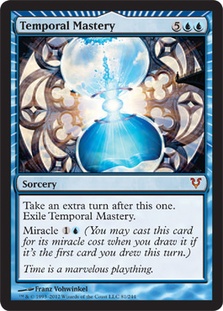(Warning: Spoilers in the Miracles section.)
Cubes
When Wizards of the Coast personnel compared Magic Online Cube drafting to Constructed queues (as a rationale for fixing the cost of Cube drafting at seven tickets), I’m not certain that they knew how popular the format would be. Whereas the Constructed queue room on Magic Online typically has 100-200 players in it, the 2,000+ players in the Limited room at 5 PM on April 6th were joining Cube queues so quickly that it was difficult to double click quickly enough to get into an event. We might assume that this preview was a success both for developers and for players! The format also is responsible for creating one of the more significant, intellectually challenging questions to be presented to Magic players in quite some time:
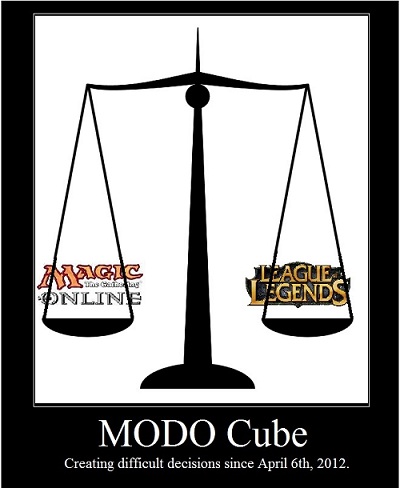
That having been said, the initial Magic Online Cube was a fairly good build, though it may have been ever so slightly too aggressive. There was a high density of cheap and effective threats, making it possible to win via combat as early as turn 4 or 5. As a competent but not amazing cube drafter, I was able to play some very aggressive builds…
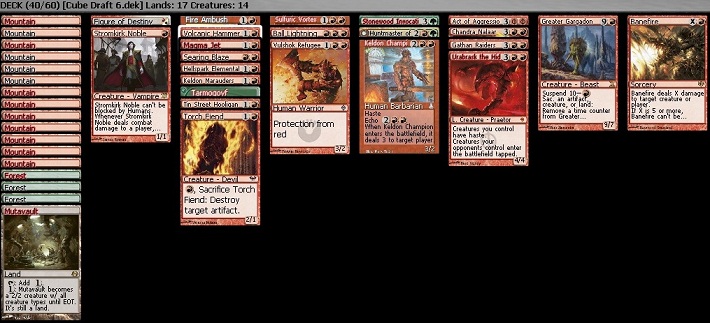
…and compared to some of the insane lists I saw posted on Facebook, this one is fairly tame. It still has the potential to win very quickly. Draws such as Stromkirk Noble, Keldon Marauders, Hellspark Elemental, Fire Ambush, and three Mountain can win before an opponent has played a fourth land, making drafting "cute" combo decks or "draw-go" style control decks much more difficult to pilot successfully.
Other midrange archetypes were still viable, though. I saw quite a few G/u concoctions echoing the principles behind the old Critical Mass deck, and I played the following list to the finals of a queue, only to lose to a masterful Psychatog deck complete with Upheaval.
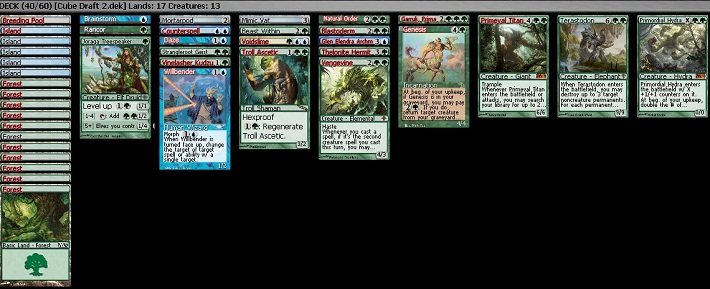
Perhaps the most interesting observation that has been circulating, especially among newer "cubers," is the relative power level of "bombs" when they’re all in the same context. For instance, Keiga, the Tide Star resonates with me as being extremely powerful because of its bygone context in Standard (i.e., U/r Magnivore decks) and because it was a clear first pick in Limited, but it’s simply an average card in the Magic Online Cube given the power level of the cards that since have been released. On the other hand, cards like Tooth and Nail are exponentially better in a Limited format where your deck might very realistically contain Urabrask the Hidden and Ulamog, the Infinite Gyre, and even "old school" strategies like failing to play a land on the first turn on the draw, discarding a card like Akroma, Angel of Wrath, and casting Reanimate on turn 2 are viable.
All in all, I expect that most players eagerly await the Magic Online Cube’s return (no release date has yet been specified). Even the short time that Cube was online, though, does suggest one potential concern. The payout for Cube drafts was handled with Innistrad and Dark Ascension booster packs, and the cost to play was a reasonable seven tickets. What this appears to have done, however, is flood the market (temporarily) with booster packs from these sets. At first, I was unconcerned with this phenomenon, as the prices of packs online shift rather quickly when payouts for non-block draft formats change or new formats are introduced.
In this particular instance, in terms of packs (which most savvy players purchase from one of the bot networks or from each other) Cube drafts had the effect of both decreasing the cost to draft a "normal" Limited format and decreasing the absolute value of the prize payout. However, intuitively, it would seem that the reduction in cost would be proportional to the reduction in prize payout, and so the relative experience for the player would remain consistent, although packs in the abstract would be somewhat devalued.
As an anecdotal case study, after my first Cube draft on Friday afternoon I was able to sell Innistrad packs to bots for around 3.85 tickets and Dark Ascension packs for around 3.35 tickets. However, when I went to "cash out" my pile of packs on Sunday after having finished with my Cube drafts, I noticed that Innistrad packs were being purchased for 3.35 tickets and Dark Ascension packs for 2.8 tickets, so I simply held onto the packs. It’s unclear whether this impact on the price of booster packs would be sustained if Cube drafting were to become a long-term component of Magic Online. However, it’s interesting to examine a typical DII draft in terms of cost/reward on April 6th vs. April 8th, with the only significant intervening factor (to my knowledge) being the short-term introduction of Cube drafting.
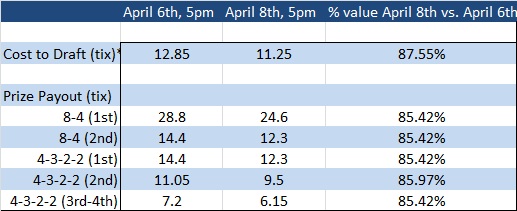
As expected, the percentage change in the value of prize payouts over the weekend closely mirrored the percentage change in entry cost (this is entirely sensible since the cost to enter is calculated using the same two "units" as the prize payouts, which have fixed values in this cross-sectional example). However, it’s informative to see the numbers plainly laid out to verify that players aren’t really "losing" anything by virtue of the fact that the Cube drafts paid out with packs from the current drafting block as long as they’re retaining their investment within the confines of Magic Online. However, players who chose to partake in the 4-3-2-2 Cube drafts were able to "re-buy" their draft if they won the first round on Friday, whereas they needed to purchase an additional ticket (roughly) to play again on Sunday.
Miracles
Depending on who we talk to, these cards are either absolutely insane or they’re terrible. One thing that is less debatable, though, is the fact that they get significantly (perhaps exponentially) better in older formats, especially Legacy. However, in these formats they have significantly stronger cards against which to compete.
The fact that Thunderous Wrath costs six mana means that it rarely will be cast for its actual mana cost in Legacy—sure, there will be niche cases of mana flood, etc. But the real test for the card will be how well it fits into the format with its miracle cost. At first blush, the miracle mechanic is designed to interact with cards like Brainstorm, Ponder, and Sensei’s Divining Top. Conveniently, between eight and ten copies of these cards are found in the premier tempo deck in Legacy: RUG. For example, last weekend’s StarCityCames.com Legacy Open in Des Moines was won by RUG Tempo.
Creatures (12)
Lands (19)
Spells (29)
- 4 Brainstorm
- 4 Lightning Bolt
- 3 Force of Will
- 3 Daze
- 4 Stifle
- 3 Spell Snare
- 4 Ponder
- 2 Forked Bolt
- 1 Dismember
- 1 Thought Scour
Sideboard

First, the idea of flipping a Delver of Secrets by revealing and then playing a Thunderous Wrath is borderline filthy. That’s a very easy eight damage on turn 2 with mana left up to play another threat or to Brainstorm. The fact that Thunderous Wrath is more than just a Lava Axe means it also can fill the role of removal spells. Many RUG Tempo lists run cards like Dismember, Forked Bolt, Fire/Ice, and Chain Lightning either as removal or to provide a little bit of reach beyond the usual eleven-to-fourteen creatures.
In order for Thunderous Wrath to fit into a deck like RUG, though, the deck has to be structured in such a way that it will always be playable for its alternate cost. Although this nearly happens by default by nature of Brainstorm and Ponder, the decision for deckbuilders will be whether the additional two or three damage (over Chain Lightning or a utility spell like Forked Bolt) and the inability to hit multiple targets is worth the extra effort to set up the card.
On another planet entirely, we have Temporal Mastery. The miracle cost for Temporal Mastery turns it into a Time Walk, which, understandably, is banned in all formats but Vintage (where it’s restricted). There are potentially so many ways to abuse this card that it’s difficult to foresee how it will fit into the metagame of any given format, if at all. While Thunderous Wrath already has "ready-made" shells where it’s obvious that a burn spell for five would be good (if it can be triggered), Temporal Mastery is a trickier beast.
Clearly taking extra turns is amazing, but Time Warp is legal both in Legacy and in Modern and doesn’t currently see play. This suggests that there is no home for the "extra turn" mechanic when it costs five mana given the current suite of available cards in those formats. Now, if it weren’t for the "exile" clause on Temporal Mastery, some shenanigans involving Noxious Revival probably would ensue (Isochron Scepter?) in Modern. As it is, in fact, some sort of G/U or G/U/r deck based on the block control decks might make the transition to Standard with the ability to abuse Temporal Mastery with Noxious Revival effectively, but it’s unclear how good that would actually be.
Historically, Time Walk effects have been best utilized when they can be replicated (i.e., U/R Pyromancer when Time Warp was in Standard) or when they’re abusing symmetrical effects that, as a consequence of their symmetry, are undercosted. In a format like Legacy, it’s difficult to imagine that such a deck couldn’t evolve to fit Temporal Mastery. Between Sensei’s Divining Top, Ponder, Brainstorm, and Jace, the Mind Sculptor, there are plenty of ways to arrange a library to abuse the card (in addition to the wide variety of Scry cards like Condescend that don’t frequently see Legacy play). But once an extra turn has been taken, what of it? Are we beating in with Tarmogoyfs? Are we copying the spell with Twincast? One direction we might explore is Turboland. A very rough sketch might start like this:
Creatures (3)
Planeswalkers (3)
Lands (24)
Spells (29)

Aside from the auto-loss to Gaddock Teeg, this shell has some consistency, but Legacy is an ever-changing format and the threshold for what constitutes a competitive deck is extraordinarily high. As such, it’s likely that the optimal use of Temporal Mastery will evolve organically through hours and days of playtesting before it ever makes an appearance in a premier-level tournament.
One thing is certain, though: this is an exciting time to be playing Magic.


